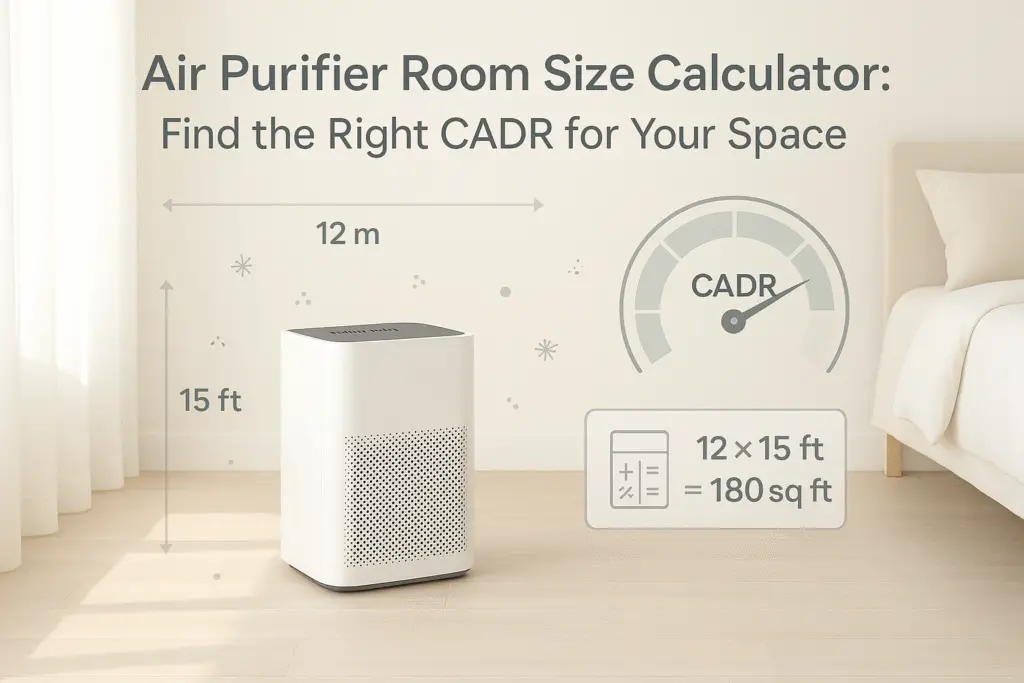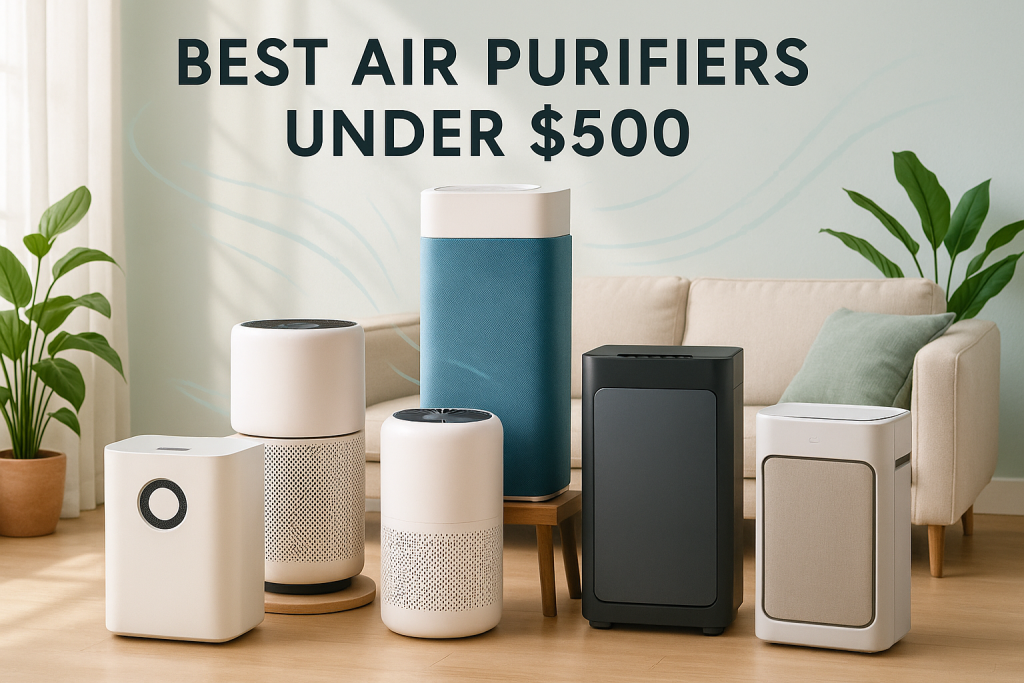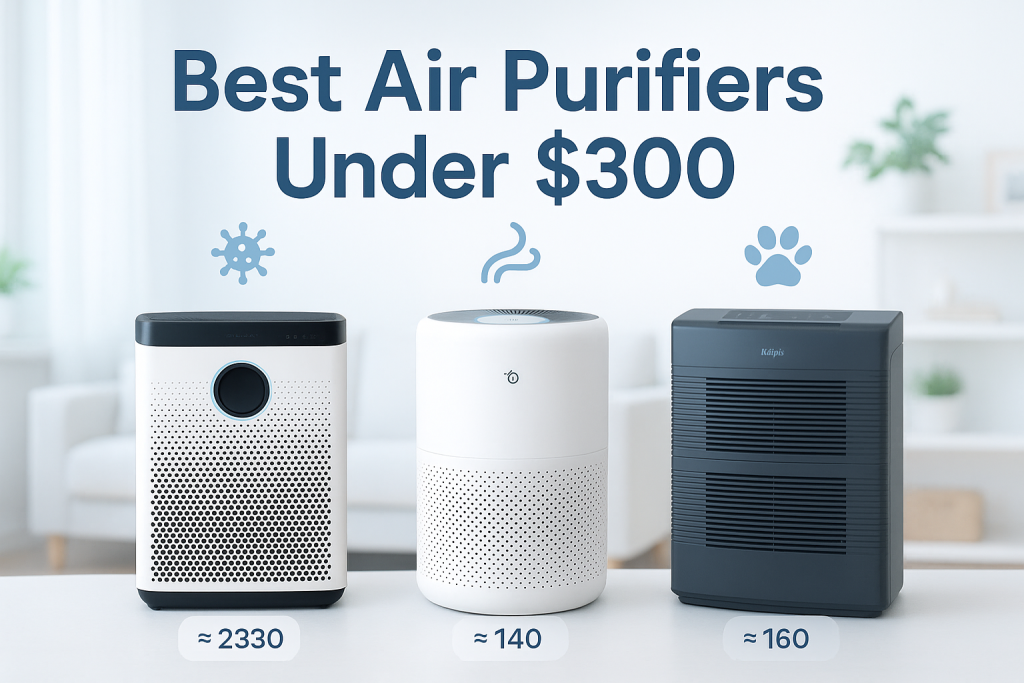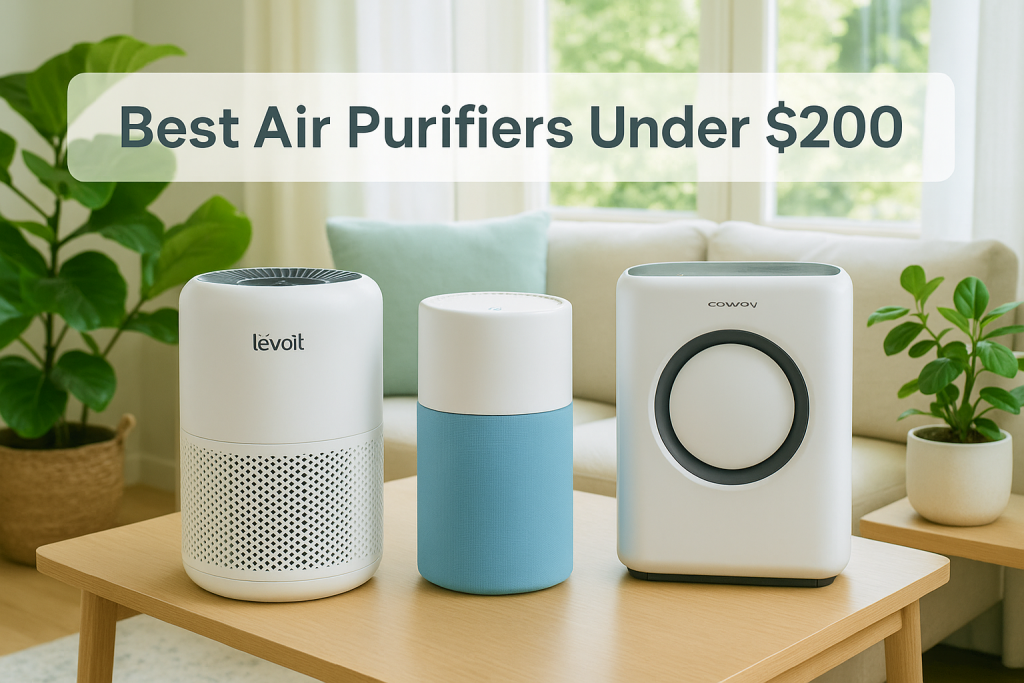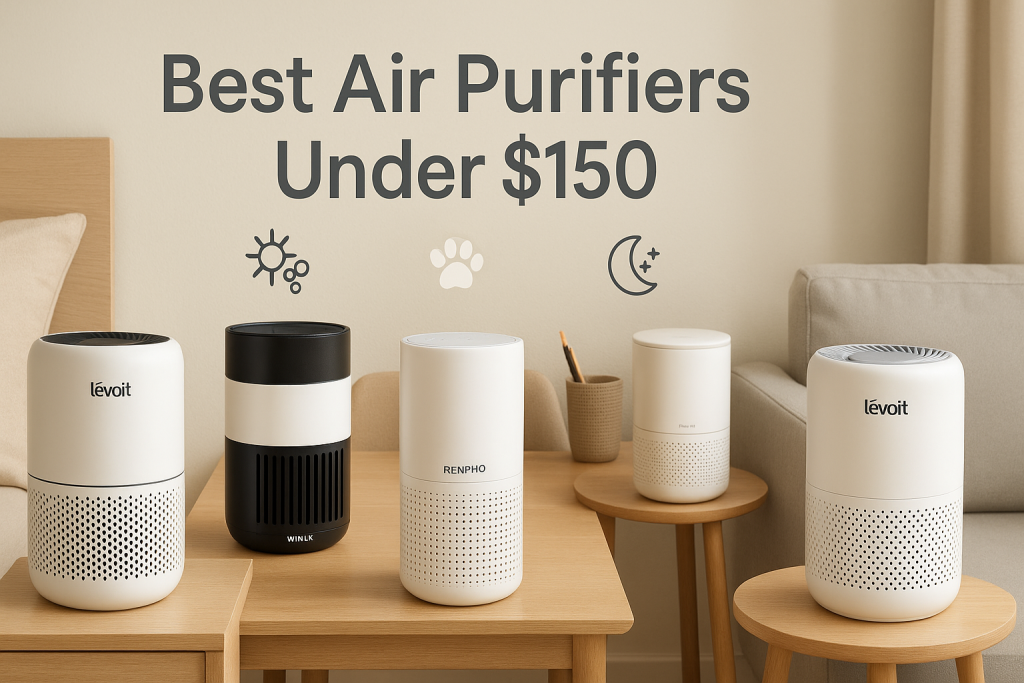Matching your air purifier to your room size is essential for effective air cleaning. The Clean Air Delivery Rate (CADR) is the key measurement that tells you if an air purifier is powerful enough for your space. Using the right CADR rating ensures your air purifier can clean your room’s air efficiently, while the wrong size may waste energy or fail to improve air quality.
This guide includes practical calculators to help you find the perfect air purifier size based on your room dimensions and specific needs. You’ll learn about CADR ratings, how to calculate the right size for different rooms, and factors beyond size that affect performance.
What is CADR and Why Does It Matter for Your Air Purifier Choice?
Clean Air Delivery Rate (CADR) is the most important metric when matching an air purifier to your room size, but it’s often misunderstood. Here’s what you need to know about this critical measurement.
CADR measures how quickly an air purifier can filter specific pollutants from your room’s air. It’s expressed in cubic feet per minute (CFM), telling you how much clean air the device delivers. Higher CADR numbers mean faster air cleaning, which is especially important for larger spaces.
| Photo | Popular Air Purifiers | Price |
|---|---|---|

|
Air Purifiers for Home Large Room up to 1500ft², Tailulu H13 True HEPA Air Purifier for Pets Dust Odor Smoke, Air Purifier for Bedroom with 15dB Quiet Sleep Mode for Bedroom Office Living Room | Check Price On Amazon |
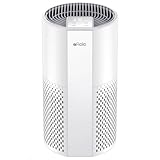
|
Afloia Air Purifier for Home, 4-in-1 Washable Filter for Allergies, Covers Up to 1076 ft², Quiet Operation, Auto Shut-Off & Night Light, Removes Pet Dander, Pollen, Dust, Mold, and Smoke, White,Pluto | Check Price On Amazon |

|
Nuwave OxyPure ZERO Air Purifier with Washable and Reusable Bio Guard Tech Air Filter, Large Room Up to 2002 Ft², Air Quality Monitor, 0.1 Microns, 100% Capture Irritants like Smoke, Dust, Pollen | Check Price On Amazon |

|
Air Purifiers for Home Large Room Up to 1,996 Ft², EOEBOT Air Purifier for Home Pets with Washable Filter, Quiet Sleep Mode, Air Quality Monitor, Air Purifier for Bedroom, Pet Hair, Dust, Smoke, White | Check Price On Amazon |

|
Afloia 2 IN 1 Air Purifier with Humidifier Combo, 3-Stage Filters for Home Allergies Pets Hair Smoker Odors, Evaporative Humidifier, Auto Shut Off, Quiet Air Cleaner with Seven Color Light,White | Check Price On Amazon |
The Association of Home Appliance Manufacturers (AHAM) developed and standardizes CADR testing. When you see an AHAM Verified mark on an air purifier, it means the unit has been independently tested for performance claims.
CADR ratings typically include three separate measurements:
- Dust CADR: Measures effectiveness against standard dust particles (0.5-3 microns)
- Pollen CADR: Measures effectiveness against larger allergen particles (5-11 microns)
- Smoke CADR: Measures effectiveness against smaller particles (0.1-1 microns)
These different ratings matter because they help you match the air purifier to your specific concerns. If you have allergies, you might prioritize pollen CADR. If you live in a wildfire-prone area, smoke CADR becomes more important.
Understanding the CADR Rating System: What the Numbers Really Mean
CADR ratings typically range from 40 to 450, with higher numbers indicating faster air cleaning. But what do these numbers actually tell you about an air purifier’s performance?
CADR ratings are determined through rigorous laboratory testing. Air purifiers are placed in a test chamber where specific pollutants are introduced. Sensors measure how quickly the air purifier removes these particles compared to the natural settling rate.
Here’s what different CADR ranges typically indicate:
- Low CADR (40-100): Suitable for small rooms like bathrooms or small bedrooms (up to about 150 square feet)
- Medium CADR (100-200): Effective for medium-sized rooms like large bedrooms or small living rooms (up to about 300 square feet)
- High CADR (200-300): Good for large rooms like living rooms or small open-concept areas (up to about 450 square feet)
- Very High CADR (300-450+): Needed for very large spaces like great rooms or open floor plans (450+ square feet)
It’s important to understand CADR limitations. The rating doesn’t measure filtration of ultrafine particles (smaller than 0.1 microns) or gaseous pollutants like VOCs. Some advanced purification technologies might perform better than their CADR ratings suggest for certain pollutants.
Interactive Air Purifier Room Size Calculator: Find Your Perfect CADR
Use our comprehensive calculator below to determine the exact CADR rating needed for your specific room size and air quality needs.
To calculate your recommended CADR:
- Measure your room’s length and width in feet
- Multiply length × width to get square footage
- Divide square footage by 1.55 to get the minimum recommended CADR
For example, a 12′ × 15′ room = 180 square feet. Dividing by 1.55 gives you a minimum CADR of 116.
For specific needs, adjust your result:
- General use: Minimum CADR (as calculated above)
- Allergies/asthma: Multiply minimum CADR by 1.5
- Pets or smoke: Multiply minimum CADR by 2
While this basic calculation provides a good starting point, several other factors can affect your ideal CADR rating, as we’ll explore in the following sections.
The Basic CADR Formula Explained (and When to Adjust It)
The standard formula for matching CADR to room size is relatively simple, but knowing when and how to adjust it for your specific situation can make all the difference in air purifier effectiveness.
The basic formula: Room Size (sq ft) ÷ 1.55 = Minimum CADR needed
This formula is based on achieving 4.8 air changes per hour (ACH), which is considered sufficient for general air cleaning in standard conditions. The 1.55 multiplier comes from AHAM’s testing methodology and has become the industry standard.
Here are real-world examples:
- Small bedroom (10′ × 10′ = 100 sq ft): 100 ÷ 1.55 = 65 CADR
- Medium living room (15′ × 20′ = 300 sq ft): 300 ÷ 1.55 = 194 CADR
- Large open concept (25′ × 30′ = 750 sq ft): 750 ÷ 1.55 = 484 CADR (may require multiple units)
When to adjust the basic calculation:
- High ceilings: For ceilings higher than 8 feet, multiply your result by (ceiling height ÷ 8)
- Open floor plans: Calculate based on the entire open area, not just one section
- Severe allergies: Increase the result by 50% for more air changes per hour
- Heavy pollution sources: Double the CADR for homes with smokers, multiple pets, or near highways
Be cautious about manufacturer claims that may not align with AHAM standards. Some brands list room coverage based on just 2 air changes per hour, which isn’t enough for effective purification.
Beyond Room Size: Critical Factors That Affect Your Air Purifier Needs
While room size is the foundation of choosing the right air purifier, several other factors can significantly impact the CADR rating you actually need for effective air cleaning.
Ceiling Height
Standard CADR calculations assume 8-foot ceilings. For higher ceilings, the air volume increases, requiring more purification power:
- For 10-foot ceilings: Multiply standard CADR by 1.25
- For 12-foot ceilings: Multiply standard CADR by 1.5
- For 15-foot cathedral ceilings: Multiply standard CADR by 1.875
Room Layout and Airflow Obstacles
Physical barriers affect air circulation, potentially reducing purifier effectiveness:
- Rooms with many partitions or large furniture pieces may need 20-30% higher CADR
- Bookshelves, curtains, and room dividers can block airflow
- L-shaped rooms may require strategic placement or multiple units
Connected Spaces
Air moves freely between connected areas:
- For rooms with permanently open doorways, calculate based on the combined square footage
- For partially connected spaces, increase CADR by 25-50% depending on the opening size
- Open kitchen/living areas should be treated as a single space
Health Considerations
Different health needs require different levels of filtration:
- Asthma or allergies: Increase CADR by at least 50%
- Respiratory conditions: Consider doubling the minimum CADR
- Immune-compromised individuals: Aim for 6+ air changes per hour
Pollution Sources
The presence of specific pollutants affects your CADR needs:
- Pets: Add 25% CADR for each large pet
- Cooking: Kitchens need 50% higher CADR to handle cooking particles
- Smokers: Double the recommended CADR
- Hobbies with dust or chemicals: Increase CADR by 50-100%
Calculating Air Changes Per Hour (ACH): Finding Your Ideal Purification Rate
Air Changes Per Hour (ACH) is a critical concept that determines how frequently the entire volume of air in your room is filtered. Here’s how to calculate the right ACH for your specific needs.
ACH represents how many times the air purifier can cycle all the air in your room each hour. Higher ACH values mean more frequent air cleaning, which is better for removing pollutants quickly.
To calculate ACH:
- Calculate room volume in cubic feet: Length × Width × Height
- Multiply your air purifier’s CADR by 60 (minutes per hour)
- Divide the result by room volume
Formula: ACH = (CADR × 60) ÷ Room Volume
Here are recommended ACH values for different situations:
- General use: 2-3 ACH is adequate for maintaining good air quality in homes without specific concerns
- Allergies/Asthma: 4-5 ACH helps keep allergen levels consistently low
- Severe allergies or smoke: 5-6+ ACH provides maximum reduction of irritants
- Medical needs: Some medical conditions may require 6-8 ACH as recommended by healthcare providers
Higher ACH settings typically mean more noise and energy consumption. Most air purifiers have multiple fan speeds that let you balance air cleaning power with noise level based on your needs.
Advanced Air Purifier Sizing: Interactive Room-Specific Calculator
Our advanced calculator takes into account the unique characteristics of your space and air quality needs to provide a more precise CADR recommendation.
For a truly accurate CADR recommendation, consider these additional factors when using the basic calculation from earlier sections:
- Room type multipliers:
- Bedroom: Standard calculation (×1)
- Living room: Add 25% (×1.25) due to higher activity
- Kitchen: Add 50% (×1.5) for cooking particles
- Basement: Add 25-50% (×1.25-1.5) for potential mold/dampness
- Occupancy adjustments:
- Add 10% per person beyond the first person
- Example: 4-person family room needs 30% more CADR than standard
- Pet considerations:
- Small pet (cat, small dog): Add 15%
- Medium dog: Add 25%
- Large dog or multiple pets: Add 40-50%
- Special pollutant concerns:
- Near highway or urban pollution: Add 25%
- Wildfire risk areas: Add 50% (focus on smoke CADR)
- Construction nearby: Add 40%
- Seasonal adjustments:
- Allergy season: Add 30-50% during peak pollen months
- Winter (windows closed): Add 20% when ventilation is reduced
These factors can be combined to find your ideal CADR. For example, a living room (25% increase) with one large dog (25% increase) near a highway (25% increase) would need approximately 75% more CADR than the basic calculation suggests.
Optimizing Air Purifier Placement: Maximizing CADR Effectiveness in Your Space
Even the perfect CADR rating won’t deliver results if your air purifier isn’t properly positioned. Here’s how to strategically place your unit for maximum effectiveness.
The placement of your air purifier can significantly impact its performance—sometimes by as much as 50%. Here are key placement principles:
- Central location: Place the purifier where air can circulate freely around it
- Avoid corners: Corner placement can reduce efficiency by 20-30%
- Keep space around unit: Maintain at least 2 feet of clearance on all sides
- Avoid obstacles: Don’t place behind furniture, curtains, or plants
- Doorway consideration: Positioning near doorways helps purify air moving between rooms
- Height matters: For most units, 3-5 feet off the ground is ideal
- Direction: Point the air output toward the center of the room
Common placement mistakes that reduce effectiveness:
- Placing units against walls or in corners
- Positioning too close to heat sources or air conditioners
- Blocking air intake or output vents
- Placing behind furniture or curtains
- Positioning in areas with stagnant air
Room-by-Room Placement Guide: Where to Put Your Air Purifier for Maximum Effectiveness
Each room in your home presents unique air purification challenges. Here’s our room-by-room guide to optimal air purifier placement based on airflow patterns and pollution sources.
Bedroom Placement
For effective bedroom air purification:
- Position 6-10 feet from your bed for best overnight breathing zone purification
- Avoid placing directly beside the bed (disrupts airflow and may cause draft)
- For allergies, position between the door and your bed to catch particles before they reach you
- Child bedrooms: Place units at least 3 feet from the bed and secure from tipping
- Keep away from curtains that might block airflow
Living Room Placement
- Central placement is ideal, often near the middle of the longest wall
- For open concept areas, position toward the center of the space
- In TV rooms, place perpendicular to the screen rather than behind furniture
- For multi-level living rooms, position at the lower level as air naturally rises
Kitchen Placement
- Position 5-6 feet away from the stove to avoid direct grease exposure
- Place between the cooking area and the rest of the home to capture spreading particles
- Avoid areas where water splashing might occur
- Consider counter placement for small units in larger kitchens
Home Office Placement
- Position between you and equipment that produces particles (printers, etc.)
- 3-4 feet from your seating position is ideal
- Keep away from computer fans that might disrupt airflow
- For small offices, elevate the unit if floor space is limited
Comparing Air Purifier Technologies: CADR Ratings Across Different Types
Not all air purification technologies are measured equally by CADR ratings. Understanding the strengths and limitations of each type helps you interpret CADR ratings more effectively.
HEPA Filtration Systems
- CADR measurement accuracy: Excellent – CADR testing was designed for HEPA systems
- Particle size effectiveness: Captures 99.97% of particles as small as 0.3 microns
- Strengths: Highly effective for dust, pollen, pet dander, and most allergens
- Limitations: Does not remove gases, VOCs, or odors without additional filters
Activated Carbon Filters
- CADR measurement accuracy: Limited – CADR doesn’t measure gaseous pollutant removal
- Particle size effectiveness: Specializes in molecules and gases, not particles
- Strengths: Excellent for odors, smoke, VOCs, and gaseous chemicals
- Limitations: Minimal effect on particle CADR ratings despite real-world benefits
Ionizers/Electrostatic Precipitators
- CADR measurement accuracy: Variable – some perform well in tests but have limitations
- Particle size effectiveness: Can capture particles down to 0.01 microns
- Strengths: Effective for very small particles, often quieter operation
- Limitations: May produce ozone, effectiveness decreases as plates get dirty
UV Germicidal Technology
- CADR measurement accuracy: Poor – CADR doesn’t measure microorganism killing
- Particle size effectiveness: Targets microorganisms rather than particles
- Strengths: Kills bacteria, viruses, and other microorganisms
- Limitations: No impact on particle CADR despite germ-killing benefits
Photocatalytic Oxidation (PCO)
- CADR measurement accuracy: Limited – benefits not fully captured in CADR tests
- Particle size effectiveness: Breaks down molecular-sized pollutants
- Strengths: Effective against VOCs, odors, and some microorganisms
- Limitations: May produce trace byproducts, slower action than particle filtration
Hybrid/Multi-Technology Systems
- CADR measurement accuracy: Good for particle removal aspects only
- Particle size effectiveness: Varies by technologies included
- Strengths: Comprehensive coverage of multiple pollutant types
- Limitations: CADR ratings may not reflect total air cleaning capability
When comparing air purifiers with different technologies, remember that CADR primarily measures particle removal efficiency. For odors, gases, or microorganisms, look beyond CADR to understand the complete performance picture.
Single Purifier vs. Multiple Units: Strategic Approaches for Whole-Home Air Quality
Should you purchase one high-CADR air purifier or multiple smaller units? This section helps you develop a cost-effective whole-home air purification strategy.
Single Large Unit Strategy
Pros:
- Usually more cost-effective initially
- Often quieter than multiple smaller units at equivalent power
- Simpler maintenance with just one filter system to replace
- More powerful for large open spaces
Cons:
- Limited coverage in rooms distant from the unit
- Closed doors block air circulation between rooms
- May be overkill for smaller spaces
- Single point of failure if the unit malfunctions
Multiple Smaller Units Strategy
Pros:
- Targeted purification for different room needs
- Continuous protection even if one unit fails
- Better coverage in multi-room homes
- Can run some units only when needed (bedrooms at night, kitchen while cooking)
Cons:
- Higher total cost initially
- More filters to replace and maintain
- May consume more total electricity
- Can be less powerful for very large spaces
Cost-Effective Multi-Room Strategy
For most homes, a hybrid approach works best:
- Primary living spaces: Invest in one higher-CADR unit for the area where you spend most waking hours
- Bedrooms: Use medium-CADR units sized specifically for each room
- Problem areas: Add targeted units for specific concerns (kitchen, hobby room, basement)
- Priority ranking: If budget is limited, prioritize bedrooms (where you spend 8 hours daily) and main living areas
For a 1,500 sq ft home, instead of one large unit (CADR 300+), consider:
- Living/dining area: CADR 200-250
- Main bedroom: CADR 100-150
- Additional bedrooms: CADR 80-100 each
This approach often provides better overall air quality while allowing for customized purification based on each room’s specific needs.
Maintaining Effective CADR: Ensuring Your Air Purifier Performs at Its Rated Capacity
Your air purifier’s actual performance will decline over time if not properly maintained. Here’s how to ensure your unit continues to deliver its rated CADR throughout its lifetime.
As filters capture particles, airflow decreases, reducing CADR performance. Regular maintenance is essential to maintain rated effectiveness:
Signs of Declining CADR Performance
- Noticeably reduced airflow from output vents
- Unit running louder than usual at the same setting
- Visible dust accumulation on or around the unit
- Return of allergy symptoms or odors previously controlled
- Filter indicator light activated (on applicable models)
- Longer running time required to clear visible air particles
Performance Impact of Neglected Maintenance
- 25% clogged filter: 15-20% reduction in CADR
- 50% clogged filter: 30-50% reduction in CADR
- 75% clogged filter: 50-70% reduction in CADR
- Completely clogged: Up to 90% reduction or complete effectiveness loss
General Maintenance Schedule
- Weekly: Vacuum external case and intake grills
- Monthly: Check pre-filters and clean if dirty
- Quarterly: Deep clean washable pre-filters, check main filters
- According to schedule: Replace main filters (HEPA/carbon)
Filter Replacement Timeline: When and How to Maintain Peak CADR Performance
Different components of your air purifier need maintenance at different intervals. Follow this timeline to maintain optimal CADR performance throughout your unit’s lifespan.
Pre-Filter Maintenance
- Cleaning frequency: Every 2-4 weeks for visible dust; monthly minimum
- Cleaning method: Vacuum with brush attachment or wash if manufacturer allows
- Replacement: Every 3 months if washable; follow manufacturer guidelines
- Impact on CADR: Dirty pre-filters can reduce overall CADR by 15-30%
HEPA Filter Replacement
- Average lifespan: 6-12 months under normal conditions
- Heavy pollution homes: 3-6 months (smoking, multiple pets, construction)
- Replacement indicators: Gray/brown discoloration, visible dirt, reduced airflow
- CADR impact: Efficiency drops steadily after 6 months in most environments
Activated Carbon Filter Replacement
- Average lifespan: 3-6 months (carbon becomes saturated faster than HEPA clogs)
- Usage factors: Cooking odors, pets, and chemicals accelerate saturation
- Replacement indicators: Return of odors previously controlled by the unit
- Note: Carbon filters may look clean even when completely ineffective
UV Bulbs (If Applicable)
- Average lifespan: 9-14 months of continuous operation
- Replacement indicators: Dimming light or indicator on control panel
- Effectiveness impact: UV effectiveness decreases as bulbs age
Ionizer Components (If Applicable)
- Cleaning frequency: Every 2-4 weeks for collection plates
- Cleaning method: Follow manufacturer instructions for safe cleaning
- Performance impact: Dirty collection plates significantly reduce effectiveness
Environmental Factors Affecting Maintenance Schedule
Adjust your maintenance schedule based on these factors:
- Pets: Each pet may reduce filter life by 20-30%
- Smoking: Reduces filter life by 40-60%
- Construction/renovation: Can reduce filter life by up to 70%
- Seasonal factors: Pollen season, wildfire season may require more frequent maintenance
- Running hours: Units running 24/7 need more frequent maintenance than occasional use
Verifying Air Purifier Performance: Testing if Your Unit Delivers Its Promised CADR
How do you know if your air purifier is actually delivering its rated CADR in your specific environment? Here are practical methods to verify performance in real-world conditions.
Visual Testing Methods
- Dust test: Introduce visible dust nearby (shake a blanket or cushion) and time how quickly it clears
- Incense or smoke test: Light and extinguish incense and observe smoke clearance time
- Flashlight beam test: Shine a bright flashlight through the room in darkness to observe floating particles before and after purifier use
Air Quality Monitor Testing
For more precise measurement, consumer air quality monitors can provide quantitative data:
- Particle counter test: Measure baseline particle counts, run the purifier for 30-60 minutes, then measure again
- Reduction percentage: Calculate how much the particle count dropped compared to expected reduction based on CADR
- Time-to-clean test: How long it takes to reduce particles by 80% compared to theoretical time based on room size and CADR
Monitoring Options
- Built-in sensors: Many newer air purifiers include particle sensors with app reporting
- Consumer air quality monitors: Standalone devices that measure particles, sometimes VOCs
- Professional testing: Services that use calibrated equipment for precise measurement
Common Reasons for Performance Gaps
If your air purifier isn’t performing as expected, consider these common causes:
- Clogged or overdue filters needing replacement
- Incorrect size for the space (undersized unit)
- Poor placement reducing effective air circulation
- Running on too low a fan setting
- Continuous sources of new pollution overwhelming capacity
- Doors or windows frequently open, introducing new particles
Frequently Asked Questions About Air Purifier Sizing and CADR
We’ve compiled and answered the most common questions about air purifier sizing, CADR ratings, and optimization for different spaces.
Is higher CADR always better?
Higher CADR means faster air cleaning, but it’s not always necessary or better. For small rooms, an oversized purifier may waste energy and create excessive noise. Match the CADR to your room size and specific needs rather than automatically choosing the highest available.
Do I need different CADR ratings for different pollutants?
Yes, CADR ratings vary by pollutant type (dust, pollen, smoke). Prioritize the rating that matches your primary concern. If you have allergies, focus on pollen CADR. If you’re concerned about wildfire smoke or have a smoker in the home, prioritize the smoke CADR rating.
How do I calculate needs for odd-shaped rooms?
For L-shaped or other irregular rooms, either calculate based on the total square footage or divide the space into rectangles, calculate each separately, and add them together. For very irregular spaces, using multiple smaller units may be more effective than one large unit.
What CADR do I need for connected rooms with open doorways?
For rooms with permanently open doorways, calculate based on the combined square footage of both spaces. For rooms with doors that are sometimes closed, size the purifier for the room where it will be located, but increase the CADR by 25-50% to account for the additional space when doors are open.
How does furniture affect air purifier effectiveness?
Heavy furniture can block airflow and create “dead zones” where air circulates poorly. In heavily furnished rooms, increase your target CADR by 20-30% and position the purifier where air can flow freely around it, not behind furniture or in corners.
Should CADR requirements change seasonally?
Yes, seasonal factors can affect your CADR needs. During high pollen seasons, wildfire season, or winter when windows stay closed, you may need higher CADR or longer running times. Many users benefit from adjustable speed settings that can be increased during high-pollution periods.
How do I calculate needs for very high ceiling rooms?
For rooms with ceilings higher than 8 feet, multiply your calculated CADR by (ceiling height ÷ 8). For example, with 12-foot ceilings, multiply by 1.5. For cathedral ceilings, use the average height. Remember that warm air rises, so purifier placement becomes even more important in high-ceiling rooms.
What’s more important – CADR or filtration technology?
Both matter for different reasons. CADR tells you how quickly the purifier can clean your air, while filtration technology determines what types of pollutants it removes. For particle removal (dust, pollen, pet dander), CADR is very important. For odors, gases, or VOCs, the type of filtration technology (like activated carbon) becomes more critical.
Will one air purifier work for my entire apartment?
A single air purifier will primarily clean the room it’s in, with limited effect on other rooms, especially if doors are closed. For whole-apartment purification, either select a very high-CADR unit centrally located with interior doors kept open, or use multiple units strategically placed in different rooms.
How do smart features affect CADR performance?
Smart features like auto-mode, air quality sensors, and app control don’t directly affect the maximum CADR, but they can optimize performance by automatically adjusting fan speeds based on detected pollution levels. This helps maintain good air quality while minimizing noise and energy consumption during clean-air periods.
How do air purifiers compare to HVAC filters?
HVAC filters clean air throughout your home but typically have lower MERV ratings than dedicated air purifiers and only work when the system is running. Air purifiers clean smaller areas more intensively and run independently of heating/cooling needs. For best results, use both: a good HVAC filter (MERV 11+) for whole-home baseline filtration and targeted air purifiers in rooms where you spend the most time.
Conclusion: Making the Right CADR Choice for Your Unique Space
Selecting the right CADR rating for your space involves understanding both the science of air purification and the unique characteristics of your environment.
The basic formula (Room Size ÷ 1.55 = Minimum CADR) provides a starting point, but for truly effective air purification, consider your specific circumstances: ceiling height, room layout, health needs, pollution sources, and connected spaces all affect your ideal CADR rating.
Remember that placement significantly impacts performance—even the perfect-sized air purifier won’t work effectively if positioned incorrectly. Center placement with good clearance around the unit maximizes air circulation and cleaning efficiency.
Regular maintenance is essential for sustained performance. As filters collect particles, CADR effectiveness decreases dramatically. Follow the maintenance schedule for your specific model to ensure continued optimal performance.
Take action today by measuring your rooms, calculating your recommended CADR using the formulas provided, and evaluating your current air purifier against these guidelines. If you’re shopping for a new unit, use these calculations to narrow your search to appropriately sized models for your space.
Clean air is fundamental to health and comfort. With the right CADR rating, optimal placement, and proper maintenance, your air purifier will effectively create the healthy environment you and your family deserve.
| Photo | Air Purifier Model | Best for | Price |
|---|---|---|---|

|
LEVOIT Air Purifier | Best Overall | Check Price On Amazon |

|
WINIX A231 Air Purifier | Asthma & Indoor Pollution | Check Price On Amazon |

|
Rabbit Air, A3 SPA-1000N Air Purifier | Pet Dander & Odors | Check Price On Amazon |

|
GermGuardian Air Purifier | Cigarette & Cooking Smoke | Check Price On Amazon |

|
Coway Airmega Air Purifier | New-borns | Check Price On Amazon |

|
BLUEAIR Air Purifier | Germ & Virus Control | Check Price On Amazon |
